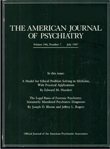Effects of Alzheimer's disease severity on cerebrospinal fluid norepinephrine concentration
Abstract
OBJECTIVE: Although loss of noradrenergic neurons in the locus ceruleus has been consistently demonstrated postmortem in Alzheimer's disease, several small studies suggest that indices of central noradrenergic activity increase with the severity of Alzheimer's disease in living patients. The authors estimated the effect of Alzheimer's disease severity on central noradrenergic activity by comparing the CSF norepinephrine concentrations of subjects with Alzheimer's disease in earlier and advanced stages. The effect of normal aging on CSF norepinephrine also was determined. METHOD: Lumbar punctures were performed in 49 subjects with Alzheimer's disease of mild or moderate severity, 25 subjects with advanced Alzheimer's disease, 42 normal older subjects, and 54 normal young subjects. Advanced Alzheimer's disease was defined prospectively by a Mini-Mental State score of less than 12. Norepinephrine was measured by radioenzymatic assay. RESULTS: CSF norepinephrine concentration was significantly higher in the patients with advanced Alzheimer's disease (mean = 279 pg/ml, SD = 122) than in those with mild to moderate severity (mean = 198 pg/ml, SD = 89), normal older subjects (mean = 219 pg/ml, SD = 88), or normal young subjects (mean = 154 pg/ml, SD = 53). CSF and plasma norepinephrine levels and mean arterial blood pressure all were higher in the older subjects than in the young subjects. CONCLUSIONS: Despite the loss of locus ceruleus neurons in Alzheimer's disease, the aging-associated high concentration of CSF norepinephrine is retained in the earlier stages of Alzheimer's disease and increases further as the disease progresses. Increased brain noradrenergic activity may contribute to the agitated behaviors or cognitive deficits of patients with advanced Alzheimer's disease.



